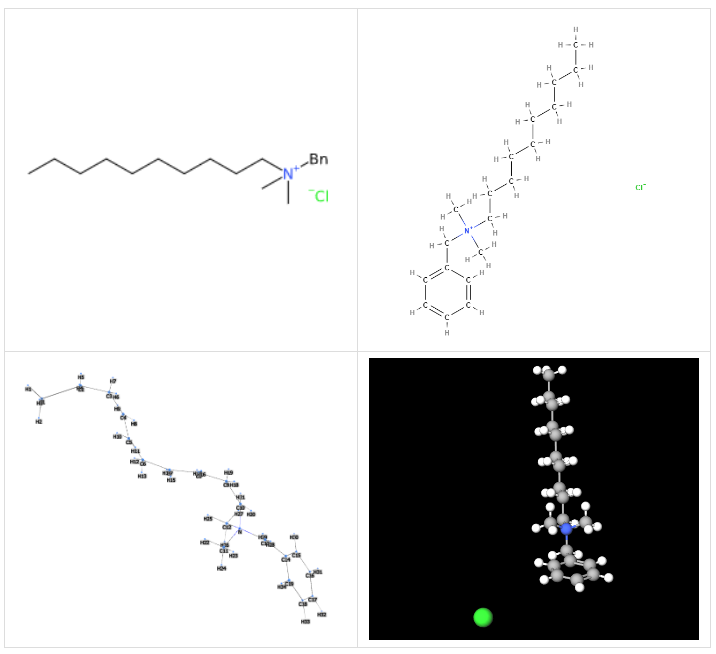Check the ingredients!
... live healthy!


| "Descrizione" by A_Partyns (12876 pt) | 2024-Mar-22 19:34 |
| Evaluation | N. Experts | Evaluation | N. Experts |
|---|---|---|---|
| 1 | 6 | ||
| 2 | 7 | ||
| 3 | 8 | ||
| 4 | 9 | ||
| 5 | 10 |
Alkyldimethylbenzylammonium chloride or Benzalkonium chloride is a mixture of quaternary benzyl dimethyl alkylammonium chlorides and a surfactant (removes dirt particles) cationic frequently used as antiseptics, to prevent bacterial growth, in healthcare and consumer products.
Presented for the first time as antimicrobial agents by Domagk in 1935.
The name describes the structure of the molecule.
Raw Materials Used in Production.
Step-by-step Summary of Industrial Production Process.
It appears as a colourless liquid.

Disinfection
Benzalkonium chloride solutions for hospital use tend to be neutral to alkaline, non-corrosive on metal surfaces, non-staining, and safe to use on all washable surfaces. Is also added to drug products as preservative for multiple dose containers (1).
Benzalkonium chloride (BAK) is used as a preservative in several ophthalmic antiglaucoma agents. There are numerous reports on the effects of BAK on corneal epithelial cells in vitro (2).
Safety
In the package leaflet of a widely used eye drops, Vusumidriatic, in the Warnings and Precautions it is written: Benzalkonium chloride can also cause eye irritation especially if you have dry eye or discomfort to the cornea (the uppermost transparent layer of the eye). If you experience an abnormal feeling in the eye, burning or pain after using this medicine, talk to your doctor.
Benzalkonium chloride (BAK) is the most commonly used eye drop preservative. Benzalkonium chloride has been associated with toxic effects such as “dry eye” and trabecular meshwork degeneration, but the underlying biochemical mechanism of ocular toxicity by BAK is unclear. This study propose a mechanistic basis for BAK's adverse effects (3).
This 2020 study by Jingyi Wang et al. warns of the toxicity of benzalkonium chloride to the epithelial cells of the Meibomian gland, which secretes, via its ducts, the human tear film, a major source of lipids (4).
This study from 2022, although written by employees of a private company, is well documented and reaffirms that Benzalkonium Chloride, used in approximately 70% of ophthalmic formulations, is well known to cause cytotoxic damage to conjunctival and corneal epithelial cells, resulting in signs and symptoms of ocular surface disease (5).
Cosmetics
It is a restricted ingredient V/54 and III/65 as a Relevant Item in the Annexes of the European Cosmetics Regulation 1223/2009. Substance or ingredient reported: Benzalkonium chloride, bromide and saccharinate
Antimicrobial agent. This ingredient is able to suppress or inhibit the growth and replication of a broad spectrum of microorganisms such as bacteria, fungi and viruses by making the stratum corneum temporarily bactericidal and fungicidal.
Antistatic agent. Static electricity build-up has a direct influence on products and causes electrostatic adsorption. The antistatic ingredient reduces static build-up and surface resistivity on the surface of the skin and hair.
Deodorant agent. When substances that give off an unpleasant odour are included in cosmetic formulations (typical examples are methyl mercaptan and hydrogen sulphide derived from garlic), deodorants attenuate or eliminate the unpleasant exhalation.
Preservative. Any product containing organic, inorganic compounds, water, needs to be preserved from microbial contamination. Preservatives act against the development of harmful microorganisms and against oxidation of the product.
Surfactant - Dispersing agent. Surfactant ingredient with cleaning properties that acts as a dispersing agent, capable of creating a barrier between particles by dispersing them and improving the separation between particles during the dispersion process. The particles undergo wetting, separation and then stabilisation of the suspension.
The most relevant studies on this ingredient have been selected with a summary of their contents:

References_________________________________________________________________
(1) Ahn Y, Kim JM, Lee YJ, LiPuma J, Hussong D, Marasa B, Cerniglia C. Effects of Extended Storage of Chlorhexidine Gluconate and Benzalkonium Chloride Solutions on the Viability of Burkholderia cenocepacia. J Microbiol Biotechnol. 2017 Dec 28;27(12):2211-2220. doi: 10.4014/jmb.1706.06034.
Abstract. Chlorhexidine gluconate (CHX) and benzalkonium chloride (BZK) formulations are frequently used as antiseptics in healthcare and consumer products. Burkholderia cepacia complex (BCC) contamination of pharmaceutical products could be due to the use of contaminated water in the manufacturing process, over-diluted antiseptic solutions in the product, and the use of outdated products, which in turn reduces the antimicrobial activity of CHX and BZK. To establish a "safe use" period following opening containers of CHX and BZK, we measured the antimicrobial effects of CHX (2-10 μg/ml) and BZK (10-50 μg/ml) at sublethal concentrations on six strains of Burkholderia cenocepacia using chemical and microbiological assays. CHX (2, 4, and 10 μg/ml) and BZK (10, 20, and 50 μg/ml) stored for 42 days at 23°C showed almost the same concentration and toxicity compared with freshly prepared CHX and BZK on B. cenocepacia strains. When 5 μg/ml CHX and 20 μg/ml BZK were spiked to six B. cenocepacia strains with different inoculum sizes (10⁰ -10⁵ CFU/ml), their toxic effects were not changed for 28 days. B. cenocepacia strains in diluted CHX and BZK were detectable at concentrations up to 10² CFU/ml after incubation for 28 days at 23°C. Although abiotic and biotic changes in the toxicity of both antiseptics were not observed, our results indicate that B. cenocepacia strains could remain viable in CHX and BZK for 28 days, which in turn, indicates the importance of control measures to monitor BCC contamination in pharmaceutical products.
(2) Berdy GJ, Abelson MB, Smith LM, George MA. Preservative-free artificial tear preparations. Assessment of corneal epithelial toxic effects. Arch Ophthalmol. 1992 Apr;110(4):528-32. doi: 10.1001/archopht.1992.01080160106043.
Abstract. Scanning electron microscopy was used to evaluate the corneal epithelium of rabbit eyes after administration of two preservative-free ocular lubricants, preservative-free artificial tear-1 (Hypotears PF) and preservative-free artificial tear-2 (Refresh), and 0.02% benzalkonium chloride. Animals were randomly assigned to either mild or exaggerated use regimens. A quantitative rating system was used to assess epithelial damage. With mild use, scanning electron microscopy revealed normal epithelial morphologic characteristics for both preservative-free artificial tear solutions (mean relative damage score, solution 1, 0.75 +/- 0.16; solution 2, 1.02 +/- 0.23), which were not significantly different from eyes treated with phosphate-buffered saline (1.38 +/- 0.38) or a mild dosage regimen of 0.02% benzalkonium chloride (1.20 +/- 0.12). Exaggerated use with preservative-free artificial tear solutions (solution 1, 1.31 +/- 0.21; solution 2, 1.35 +/- 0.08) induced minimal damage that was not different from control eyes treated with phosphate-buffered saline (1.26 +/- 0.13). Compared with an exaggerated use of 0.02% benzalkonium chloride (4.0 +/- 0.16), both preservative-free artificial tear solutions induced significantly less epithelial damage (P = .0001). These results suggest that with frequent-dosage regimens, preservation-free artificial tear solutions-1 and -2 are free of the toxic effects associated with preserved solutions.
(3) Datta S, Baudouin C, Brignole-Baudouin F, Denoyer A, Cortopassi GA. The Eye Drop Preservative Benzalkonium Chloride Potently Induces Mitochondrial Dysfunction and Preferentially Affects LHON Mutant Cells. Invest Ophthalmol Vis Sci. 2017 Apr 1;58(4):2406-2412. doi: 10.1167/iovs.16-20903
Abstract. Purpose: Benzalkonium chloride (BAK) is the most commonly used eye drop preservative. Benzalkonium chloride has been associated with toxic effects such as "dry eye" and trabecular meshwork degeneration, but the underlying biochemical mechanism of ocular toxicity by BAK is unclear. In this study, we propose a mechanistic basis for BAK's adverse effects....Conclusions: Benzalkonium chloride inhibits mitochondria of human corneal epithelial cells and cells bearing LHON mutations at pharmacologically relevant concentrations, and we suggest this is the basis of BAK's ocular toxicity. Prescribing BAK-containing eye drops should be avoided in patients with mitochondrial deficiency, including LHON patients, LHON carriers, and possibly primary open-angle glaucoma patients.
(4) Wang J, Liu Y, Kam WR, Li Y, Sullivan DA. Toxicity of the cosmetic preservatives parabens, phenoxyethanol and chlorphenesin on human meibomian gland epithelial cells. Exp Eye Res. 2020 Jul;196:108057. doi: 10.1016/j.exer.2020.108057.
(5) Goldstein MH, Silva FQ, Blender N, Tran T, Vantipalli S. Ocular benzalkonium chloride exposure: problems and solutions. Eye (Lond). 2022 Feb;36(2):361-368. doi: 10.1038/s41433-021-01668-x.
| Evaluate |